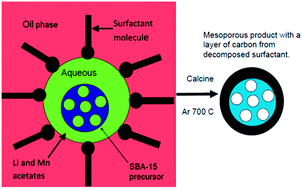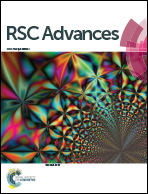Mesoporous manganese-deficient lithium manganese silicate cathodes for lithium-ion batteries†
Abstract
Mesoporous electrode materials are favourable for lithium-ion batteries as they have high surface area and provide short lithium-ion diffusion distances from the pore space into the thin pore walls. The porous morphology is also an advantage for buffering the large volume changes that can accompany lithium insertion and extraction. For this reason, this study investigates the synthesis of mesoporous lithium manganese silicate, using mesoporous silica as a template. It is shown that a mesoporous lithium manganese silicate product, retaining the mesoporous symmetry of the SBA-15 silica precursor, can be formed by emulsion synthesis followed by calcination in an inert atmosphere at 700 °C. These calcination conditions retain the decomposed surfactant as a conductive surface layer on the product phase. Undesired, electrochemically inactive MnO impurities were minimized by reducing the Li : Mn ratio to 2 : 0.7 in the starting mixture. Rietveld analysis of the X-ray diffraction patterns of the product shows that it is manganese deficient with composition Li2Mn0.87(3)SiO4 with minor impurities of MnO and Li2SiO3. Excellent reversibility is observed for these cathodes in lithium cells with a capacity of 175 mA h g−1 when cycled in constant current–constant voltage mode at a current rate of 20 mA g−1.

- This article is part of the themed collection: Materials for Energy storage

 Please wait while we load your content...
Please wait while we load your content...